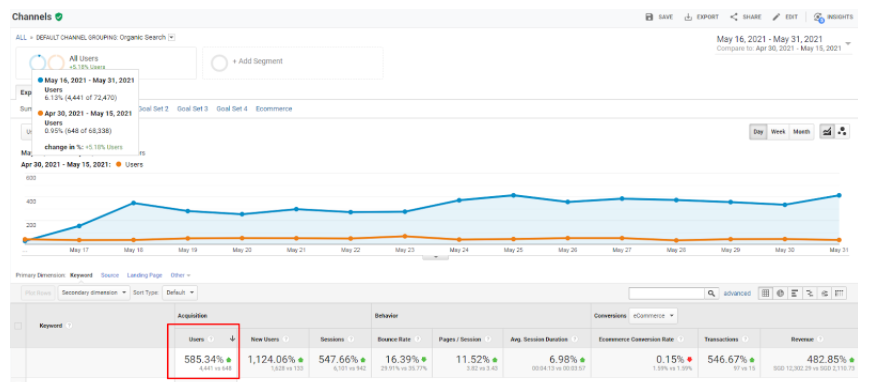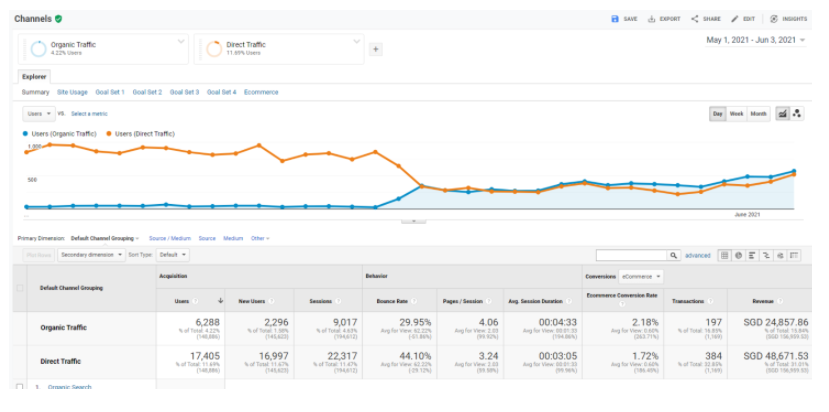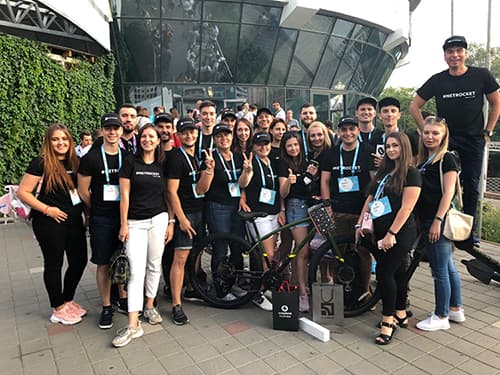Multi-Regional SEO: Unveiling the Hidden Organic Traffic
organic traffic
weeks difference
different regions

Multi-regional SEO significantly impacted organic traffic during the period from March to June 2021
About the Project
- Industry: Manufacture and sell of luxury perfumes
- Promotion Region: Singapore – the main, +40 regions
A client who is involved in the production and sale of high-end fragrances in a growing industry, approached Netrocket with a specific requirement. They wanted us to improve their website’s visibility and organic traffic by implementing comprehensive multi-regional SEO strategies. Our team of experts analyzed the current status of the website, identified potential issues and errors, and provided recommendations to further promote the platform.
For reference:
To clarify, we’re discussing direct and “dark” traffic stats in Google Analytics. Let’s break it down:
Direct traffic is a primary source of traffic, made up of people who enter the website URL directly into the address bar or search bar. These queries bypass Google search, bringing visitors to the site in the shortest possible way.
“Dark” traffic, on the other hand, is hidden traffic that may appear as direct traffic. People may come to the site through advertising on social media, email distribution, advertising campaigns, or even from organic search results. However, the system still classifies visitors as direct traffic.
“Dark” traffic distorts visitor statistics, making it challenging to accurately evaluate the effectiveness of various advertising methods. SEO specialists should quickly recognize this problem and bring “dark” traffic to light.
The Challenge
On the client’s website, there are different versions of the website for different regions, which are located in subdirectories. However, during our comprehensive multi-regional SEO audit, we identified several issues that needed to be addressed.
- Firstly, all regional versions, except the main one for Singapore, were not indexed because the canonical page was set to the main version.
- Secondly, hreflang tags, essential for sending localized page versions to Google, must be implemented correctly and were not specified for all versions.
- Thirdly, although an automatic regional redirect was established on the site, users from France were sometimes directed to the wrong version of the website. This caused some users to need help reaching the intended page.
Our SEO for multilingual websites analysis aims to fix these issues and enhance the overall performance and user experience across all regional versions of the website.
Execution / Optimization Process
- We have removed the automatic redirection by IP to regional versions of the site. This change is in line with Google’s recommendations to avoid automatic redirection based on perceived language. Doing so can prevent users and search engines from accessing all versions of the site. Instead, we now allow users to manually choose their preferred region to improve global multilingual SEO.
- To ensure successful indexing and an increase in organic traffic, we have also added rel=canonical attributes for pages of regional versions. Additionally, we have meticulously crafted hreflang attributes for all regional versions of the site.
This multilingual SEO best practices guarantee that the right version of the page is displayed prominently in search results for each region.
The Results
We noticed a significant increase in organic traffic after we fixed the technical errors. This positive result highlights the effectiveness of our specialized SEO agency for manufacturing. Our main goal is to optimize online visibility and performance for businesses in the manufacturing industry.

The remarkable increase, which soared by 585% in just two weeks compared to the previous period, exemplifies the impactful outcomes achievable under the guidance of our experienced team and positions us as a distinguished B2B SEO specialist.

Although the initial results may seem promising, after conducting a more in-depth analysis, it was discovered that the website’s traffic had actually reached this level before, but was misclassified as Direct visits. This highlights the importance of the specialized knowledge and skills possessed by our team as an SEO company for WordPress, allowing us to identify and correctly attribute the sources and characteristics of website traffic.

Summary / Conclusion Takeaways
After implementing crucial technical enhancements, such as correcting hreflang implementation and eliminating automatic redirects for specific regions, our meticulous approach to optimization yielded notable results visible in Google Analytics. While the overall traffic might not have experienced a surge, our strategic changes played a pivotal role in refining data accuracy.
For website owners, the takeaway is profound: Beyond the surface-level metrics, understanding the nuances of traffic attribution is key. Our case study highlights the significance of scrutinizing direct traffic metrics, especially if they exceed 30%. While a high direct traffic metric might initially be perceived as a testament to the company’s popularity, our findings suggest a more pragmatic interpretation. Often, Google Analytics incorrectly classifies traffic, leading to an inflated direct channel.
By addressing technical intricacies, our SEO interventions enhanced data precision and provided actionable insights. If you’re running your online business, take note – meticulous attention to technical SEO nuances can unveil hidden inefficiencies and refine your understanding of website performance, ensuring that your metrics accurately reflect the true impact of your online presence.
Explore more case studies
Check out our real-life Case Studies, that demonstrating the solid results we’ve achieved for our clients.
Do you want to achieve significant business growth?











